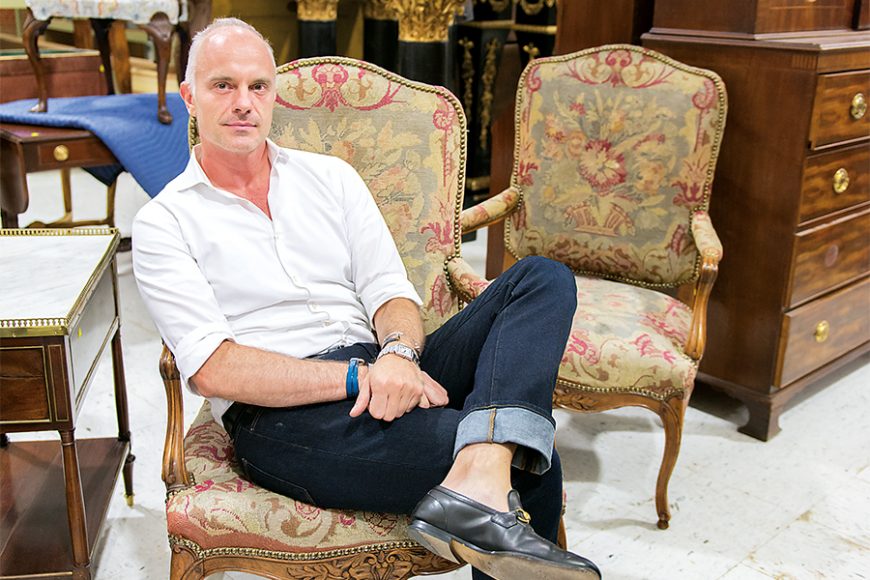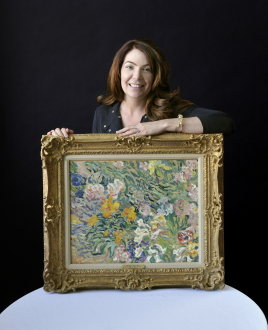We have high expectations of the place we call home. It must be comfortable, welcoming and functional. We also want it to be a place that our families, our friends and our pets enjoy and find restful.
But wait, there’s more — much more. We also want our homes to be beautiful and expressive of our tastes and life experiences. As New York-based interior designer and Skinner collaborator Phillip Thomas puts it. “Interiors should reflect people and their personalities…Visualizing an interior (and its myriad possibilities) will often allow the confidence to secure unique and one-of-a-kind items to complement or complete an interior.” The basics are the same whether the space is a grand formal drawing room or a tiny studio apartment. Balance, scale and proportion are the fundamental principles of successful design. Contrasts of color, shape and texture guarantee a pleasing result.
Designing an interior may be strictly do-it-yourself or a collaboration with professionals. However the process is managed, one of the most exciting parts is combining old and new to create that indefinable ambience that makes a place truly “home.” Thomas explains: “In my interiors, it is key that a space excite the eye and keep the onlooker engaged. This is not necessarily achieved by bright colors, for example, as one would think. What really keeps my eye engaged and interested is when an interior incorporates pieces from various eras that are made from varied materials with differing densities, reflectivities, etc. I like to feel that I create a ‘dynamic tension’ in my interiors through my selections that engages the eye and keeps it thinking about and analyzing an interior. When a space is too safe, it loses its soul.”
A room that is furnished and decorated entirely with objects from a single period, style or culture is likely to seem impersonal and academic. It can feel too much like inhabiting a museum. Variety is indeed the spice of life — and of living.
But where to begin? One proven strategy for creating a setting that expresses a unique personality is to start with a favorite object. It can be a painting, a piece of furniture, a rug, a decorative item. Each can be the nucleus of successful design in any architectural setting. It’s the mindful counterpoint between old and new, hard and soft, spare and lush, rustic and sophisticated that makes a home come alive.
For example, the signature statement from which a lovely room evolves could be a collection of antique cloisonné vases that delights the eye with fine workmanship, subtle texture and rich color. It may suggest a palette of blues and greens echoed in the upholstery and floor coverings. The contrast of sinuous curves with the sharp geometry of streamlined Modern furniture makes both styles more distinctive.
An eclectic living room can allow for time travel, taking in a George Nakashima free-form walnut table that embodies the vitality and strength of nature and a pair of Victorian chairs, whose mixed woods and rich carving showcase a different approach to the same material.
Professional designers and do-it-yourselfers alike have long recognized that antique and vintage pieces can live together harmoniously in even the most contemporary settings. Fine materials, careful workmanship and attractive lines are always in fashion. Older furniture in good condition is often better made and more affordable than many of the latest styles offered for sale. Another bonus is that the passage of time adds its own indefinable personality. By their very nature, old things are survivors and possess individuality that something fresh from the factory cannot.
Create a vibrant space by repurposing an antique or vintage item. Presenting something familiar in a new way gives it fresh appeal and makes intriguing what previously may have seemed just old-fashioned. If this is done thoughtfully, the intrinsic value of the object is preserved. Fortunately, it’s no longer the practice to drill holes in antique Chinese vases to make them into lamps.
A prime example of creative repurposing is the display of old game boards as graphic design. (See our August article, “Game On.”) Hung on a wall or mounted on a folding screen, these colorful vintage amusements take on new life as abstract art.
Outdoor furniture can flourish and function beautifully inside. Many leading mid-century furniture designers experimented with the new materials that appeared after World War II, such as aluminum, plywood, fiberglass and plastics. Sleek, functional chairs and tables were often specifically designed for the popular, less formal indoor/outdoor lifestyle. Moved from patio to parlor, a chaise by Salterini or a pair of sturdy chairs by Russell Woodard brings with them a breath of fresh air.
Whatever your aesthetic, don’t be afraid to get creative. Find what you love and build from there and feel free to create an eclectic combination of antique objects, furniture and works of art, all inspired by the world around you.
For more, contact Katie at kwhittle@skinnerinc.com or 212-787-1114.


